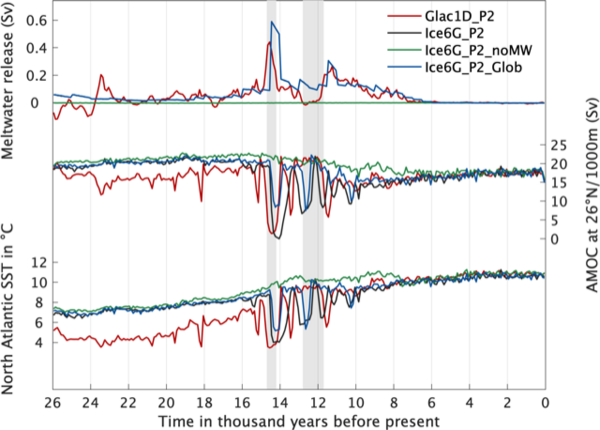What controls the millennial-scale climate variability in simulations of the last deglaciation?
During the LGM, ice sheets covered large areas of North America and Eurasia. Throughout the last deglaciation, these ice sheets disintegrated and only the Greenland and Antarctic ice sheets remain at present. Modeling this transition with comprehensive Earth system models allows us to study the climate variability during this time period and the physical processes controlling it. Due to the major changes of ice sheets during the last deglaciation, the evolution of the ice-sheet configuration and meltwater discharge from retreating ice sheets need to be prescribed in model simulations. For this, different ice-sheet reconstructions can be used. To investigate the impact of uncertainties in the reconstructions on the climate trajectory of the last deglaciation, the authors performed a comprehensive set of sensitivity experiments with MPI-ESM. The applied version of MPI-ESM is optimized for transient simulations, as it accounts for important processes associated with evolving ice sheets, such as changes in the glacier mask, topography and river pathways that occur due to changes in the ice-sheet height and extent, as well as changes in the ocean bathymetry and land-sea mask in response to meltwater release from retreating ice sheets and the accompanying sea-level rise.
By comparing simulations with prescribed ice sheets from two independent ice-sheet reconstructions, the authors show that differences in ice-sheet height in the reconstructions lead to a substantial shift of the atmospheric circulation until about 14,000 years before present. A high North American ice sheet allows for a zonalization of the jet stream, which in turn has a significant impact on the wind-driven part of the ocean circulation. The location and rate of meltwater discharge prescribed by the reconstructions results in a different timing and strength of abrupt climate events and determines whether certain climate events occur, e.g., the Younger Dryas (about 12,000 and 11,700 years before present), which was associated with an enhanced Northern Hemispheric cooling (see Figure 1). Before the Younger Dryas, large amounts of meltwater from the North American ice sheet are discharged through the Mississippi into the Gulf of Mexico in the simulations. During the Younger Dryas, small changes in the topography, which also emerge due to changes in the ice-sheets, lead to a rerouting of meltwater through the MacKenzie River into the Arctic. While such rerouting is evident in simulations with both ice-sheet reconstructions, only one of the reconstructions prescribes a sufficient amount of meltwater to significantly affect the ocean circulation. Hence, only one simulation shows a substantial freshening of the Arctic and a slowdown of the Atlantic Meridional Circulation (AMOC), which results in a Northern Hemispheric cooling. Other climate events, such as the Bølling-Allerød warming (about 14,700 to 14,200 years before present), do not occur in any of the simulations with the utilized boundary conditions. By performing sensitivity experiments with a globally homogeneous distribution of meltwater or the complete removal of meltwater, the authors further show that the millennial-scale climate variability during the last deglaciation is largely controlled by the location and amount of the meltwater discharge. If meltwater is distributed globally homogeneous, AMOC slowdowns occur but they are often weaker in strength as compared to the reference experiment (Figure 1). If meltwater discharge is neglected, the millennial-scale variability is entirely absent.
All simulations presented in this study follow the Paleo Modeling Intercomparison Project – Phase 4 (PMIP4) protocol of the last deglaciation. PMIP4 aims at comparing and evaluating simulations from different Earth system or intermediate complexity models for a variety of time periods. To better understand the interrelating processes during the last deglaciation, PMIP4 has set up a common protocol for simulations of the last deglaciation that allows for different choices of ice-sheet boundary conditions and methods of meltwater distribution. The authors show that differences in the climate response due to the different implementation choices proposed in the PMIP4 deglaciation protocol can be as large as the climate variability that the simulations try to capture. However, due to technical or computational limitations most models participating in PMIP4 will contribute only a small subset of the experiments presented in the present study. With their study, the authors aim at helping to interpret the differences between the model simulations that will be submitted to the PMIP4 deglaciation exercise. The results point towards challenges for the interpretation of the PMIP4 model ensemble and the necessity of a process-based approach for the intercomparison of the PMIP4 deglaciation simulations.

Original publication
Kapsch, M.-L., Mikolajewicz, U., Ziemen, F., und Schannwell, C. (2022) Ocean response in transient simulations of the last deglaciation dominated by underlying ice-sheet reconstruction and method of meltwater distribution. Geophysical Research Letters, 49. https://doi.org/10.1029/2021GL096767
Contact:
Dr. Marie-Luise Kapsch
Max Planck Institute for Meteorology
Email: marie-luise.kapsch@mpimet.mpg.de
Uwe Mikolajewicz
Max Planck Institute for Meteorology
Email: uwe.mikolajewicz@mpimet.mpg.de
Dr. Florian Ziemen
German Climate Computing Center
Email: ziemen@dkrz.de
Dr. Clemens Schannwell
Max Planck Institute for Meteorology
Email: clemens.schannwell@mpimet.mpg.de
